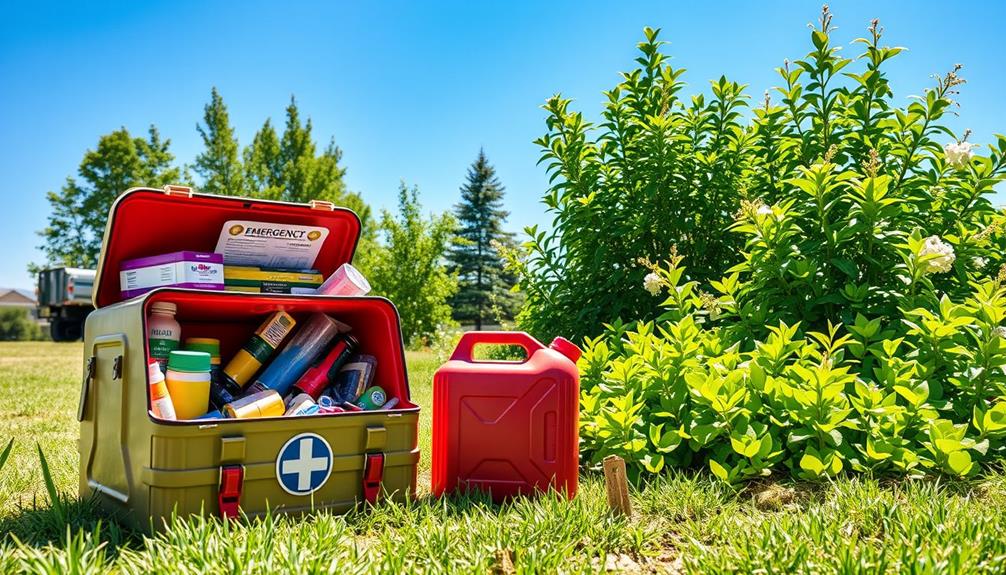To access your emergency preparedness, keep your fuel tank at least half-full. This simple tip guarantees you're ready for sudden evacuations or breakdowns. A full tank allows you to power essential devices during outages and helps prevent costly engine repairs. By refueling at a quarter tank and choosing high-turnover gas stations, you promote better engine health and fuel efficiency. Additionally, equip your vehicle with an emergency kit containing essentials like first aid supplies and water. Staying prepared leads to smoother handling of unexpected situations, and there's much more you can discover to enhance your readiness.
Key Takeaways
- Maintain at least a half-full fuel tank to ensure you're prepared for emergencies and unexpected evacuations.
- Keep a well-stocked emergency kit in your vehicle, including a first aid kit and basic tools.
- Regularly refuel at a quarter tank to avoid running low on fuel and to support engine longevity.
- Familiarize yourself with common car emergencies and practice defensive driving strategies for safer travel.
- Monitor fuel prices and utilize apps to find the best stations, promoting cost-effective refueling.
Importance of the Half-Tank Rule

Keeping your fuel tank at least half-full is a simple yet essential practice that prepares you for emergencies and unexpected travel. This habit guarantees you won't run out of gas during critical situations, providing peace of mind.
With a half-full tank, you can handle sudden evacuations or long drives without stress. Plus, having enough fuel allows you to power essential devices during outages, enhancing your overall vehicle reliability.
Moreover, keeping your tank above the halfway mark helps maintain engine performance by preventing sediment accumulation. As a result, your vehicle operates more efficiently, reducing the likelihood of costly repairs.
Enhanced Vehicle Longevity

Maintaining a half-full fuel tank considerably contributes to your vehicle's longevity and efficiency. It keeps the fuel pump submerged, preventing overheating and extending its lifespan.
A well-fueled tank minimizes air space, reducing moisture accumulation that can lead to fuel line freezing in colder weather. This practice also decreases the chances of drawing in contaminants, promoting cleaner fuel delivery and enhancing engine health.
As a result, you'll enjoy better mileage and fewer repairs, saving you time and money in the long run. By following the half-tank rule, you're not just ensuring your vehicle runs smoothly; you're also investing in its durability and reliability for years to come.
Defensive Driving Strategies

A well-maintained vehicle isn't just about longevity; it also plays a key role in your safety on the road.
To enhance your defensive driving, stay alert and minimize distractions. Always follow traffic laws and adjust your speed according to conditions. Maintain a safe distance from the vehicle ahead, giving yourself ample time to react to sudden stops or emergencies.
Anticipate potential hazards by scanning your surroundings frequently, including blind spots. Use your mirrors effectively and signal your intentions early. Practicing these defensive driving techniques boosts your adaptability to unexpected situations.
Additionally, familiarize yourself with emergency scenarios, so you can respond calmly and confidently if something goes wrong. Staying prepared is key to ensuring your safety and that of others on the road.
Emergency Preparedness Essentials

When it comes to emergency preparedness, having the right essentials can make all the difference in a crisis. Start by keeping a well-stocked emergency kit in your vehicle, including a first aid kit, flashlight, non-perishable snacks, and water. It’s also important to have emergency supplies at home, such as extra food, water, and a backup power source. Additionally, staying informed about potential disasters in your area and having a communication plan with your loved ones can bring a mindful zen for preparedness. Being proactive and ready for any emergency can bring peace of mind and ensure your safety during unexpected events.
Don't forget a multi-tool and jumper cables, as these can be lifesavers in unexpected situations. Make certain your spare tire is in good condition and that you know how to change it.
Familiarize yourself with your vehicle's manual, as it contains valuable information for emergencies. Finally, make sure your phone is charged and consider carrying a portable charger.
Consistent Refueling Techniques

How can you guarantee your fuel tank stays ready for any emergency? Start by refueling at a quarter tank. This keeps you consistently above the half-tank threshold, ensuring you're prepared for sudden travel needs.
Choose high-turnover gas stations; they provide fresher fuel, enhancing your engine's performance. Use apps to locate nearby stations and set reminders on your phone for refueling intervals.
Monitoring fuel prices can also save you money—fill up when prices dip. By adopting these consistent refueling techniques, you'll not only maintain your tank but also promote vehicle longevity and efficiency.
Common Car Emergencies

Ever wondered what you'd do if your car suddenly breaks down or you face an unexpected flat tire? Knowing how to handle common car emergencies can save you time and stress. Here's a quick reference for essential actions:
| Emergency | Action Steps | Items to Keep Handy |
|---|---|---|
| Flat Tire | Change it using a spare and jack | Spare tire, jack, wrench |
| Dead Battery | Jump-start with cables or call for help | Jumper cables, gloves |
| Overheating Engine | Turn off AC, pull over, and let it cool | Water, cooling system fluid |
Keeping an emergency kit stocked with these essentials can make a world of difference when you're in a pinch. Being prepared means you'll handle these situations with ease.
Final Thoughts on Fuel Management

Managing fuel effectively is just as important as knowing how to handle common car emergencies. By following the half-tank rule, you guarantee your vehicle is ready for unexpected situations, reducing the risk of running out of gas when you need it most.
Keeping your tank at least half-full not only provides peace of mind but also supports your engine's performance and longevity. Remember to refuel when your tank hits a quarter full, and choose high-turnover stations for peak fuel quality.
Regularly monitoring prices can help you save money, too. By prioritizing fuel management, you enhance your overall safety and preparedness while driving, making it easier to tackle any emergency that comes your way.
Frequently Asked Questions
How Does Weather Affect Fuel Efficiency and Consumption?
Weather affects your fuel efficiency and consumption considerably. Cold temperatures can decrease engine performance and increase fuel usage, while hot weather may lead to increased reliance on air conditioning, further impacting overall fuel economy. Stay mindful!
What Are the Benefits of Premium Vs. Regular Fuel?
Choosing between premium and regular fuel's like picking between a cozy blanket and a rough sheet. Premium boosts performance and efficiency, while regular's easier on your wallet. You'll feel the difference when you drive.
Can Fuel Additives Improve Engine Performance?
Yes, fuel additives can improve engine performance. They clean injectors, enhance combustion efficiency, and reduce deposits, leading to smoother operation and better mileage. Regular use might help your vehicle run more efficiently and last longer.
How Often Should I Check My Fuel Filter?
You should check your fuel filter every 10,000 to 15,000 miles. A clogged filter can reduce fuel efficiency by up to 25%. Regular checks keep your engine running smoothly and enhance overall vehicle performance.
What Should I Do if I Run Out of Gas?
If you run out of gas, stay calm. Find a safe spot, turn on your hazard lights, and call for assistance. If possible, walk to the nearest gas station for help or fuel.
Conclusion
By embracing the half-tank rule, you're not just filling your gas tank; you're fueling your peace of mind. Like a well-prepared scout, you'll navigate life's unexpected twists with confidence and ease. Keeping your tank at least half-full guarantees you're always ready for anything, from spontaneous road trips to emergencies. So, make this simple habit part of your routine and watch as it transforms your driving experience, keeping you safe and prepared for whatever comes your way.










